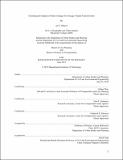Estimating the impacts of route changes for Chicago's rapid transit system
Author(s)
Ofsevit, Ari T.
Download1140223429-MIT.pdf (28.70Mb)
Other Contributors
Massachusetts Institute of Technology. Department of Urban Studies and Planning.
Massachusetts Institute of Technology. Department of Civil and Environmental Engineering.
Advisor
Jinhua Zhao, John P. Attanucci, and Frederick P. Salvucci.
Terms of use
Metadata
Show full item recordAbstract
The Chicago Transit Authority is the second largest transit agency in the US, and the CTA's rail transit division currently serves nearly half of the rides in the system. The system is adaptable to changes in population and ridership demand: most lines can be run either across the original Loop 'L' elevated lines, or through the mid-20th Century-era subways, with the additional option for lines on the Loop of either running back to their originating terminal or through the downtown to a terminal elsewhere in the system. Ridership has grown significantly in recent decades but the current route structure is not optimized for current demand, leading to portions of the system which are underutilized and others which are overburdened and congested. As ridership has grown, congestion has increased on certain portions of the system, especially on the Loop, where up to 35 trains per hour are run on certain line segments. Yet in the subways below, some tracks see as few as 10 trains per hour during the same time period. This research will investigate means of reducing this congestion and improve service, and analyze and recommend several routing alternatives which would reallocate some resources from the Loop 'L' to the subways, reducing congestion on the Loop while maintaining or increasing overall throughput through the downtown area. While long-term growth may require additional capital resources, this research proposes low-cost operational changes which will not require significant new structures, stations, yards or equipment outlay. The analysis breaks down current passenger use to estimate the travel time impacts of various alternatives for passengers and the potential to draw new ridership to the system, the operational impacts (congestion and delay reduction, yard operations, safety, etc.) and cost to the agency, and how these changes may be piloted, implemented and further evaluated in concert with the agency's planned capital improvements to keep pace with growing demand at peak times. The results of this research show that there are benefits to both congestion and passenger travel from running less service all the way around the elevated Loop and adding more thru-routing service patterns. Congestion is reduced by removing some trains from the most congested portions of the elevated structure and reallocating them to existing capacity in the subway. Passengers benefit as fewer transfers are required between lines, and more locations are accessible via direct, one-seat rides. While this represents a significant departure in route structure from the current Loop operation, where four of the five lines operating on the Loop make a full circuit and return to their original terminal, there are measurable benefits for both passengers and operations.
Description
This electronic version was submitted by the student author. The certified thesis is available in the Institute Archives and Special Collections. Thesis: M.C.P., Massachusetts Institute of Technology, Department of Urban Studies and Planning, 2019 Thesis: S.M. in Transportation, Massachusetts Institute of Technology, Department of Civil and Environmental Engineering, 2019 Cataloged from student-submitted PDF version of thesis. Includes bibliographical references (pages 142-150).
Date issued
2019Department
Massachusetts Institute of Technology. Department of Urban Studies and Planning; Massachusetts Institute of Technology. Department of Civil and Environmental EngineeringPublisher
Massachusetts Institute of Technology
Keywords
Urban Studies and Planning., Civil and Environmental Engineering.